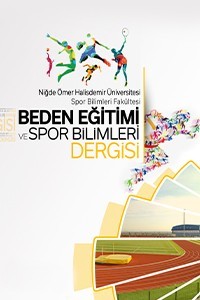AEROBİK YÜZME ANTRENMANLARININ SEDANTER KADINLARDA BAZI FİZİKSEL VE FİZYOLOJİK PARAMETRELERE ETKİLERİ
Sedanter, yüzme, aerobik egzersiz, vücut kompozisyonu, fizyolojik parametre
AEROBIC SWIMMING TRAINING’S EFFECTS ON SOME PHYSICAL AND PHYSIOLOGICAL PARAMETERS IN SEDANTARY WOMEN
Sedentary, swimming, aerobic exercise, body composition, physiological parameter,
___
- 1. Anderson, M., Hopkins, W., Roberts, A., & Pyne, D. (2008). Ability of test measures to predict competitive performance in elite swimmers. Journal of Sports Sciences, 26(2), 123-130.
- 2. Barbosa, T.M., Costa, M., Marinho, D.A., Coelho, J., Moreira, M., & Silva, A.J. (2010). Modeling the links between young swimmers' performance: energetic and biomechanic profiles. Pediatric Exercise Science, 22(3), 379.
- 3. De Mello Vitor, F., & Silveira Böhme, M. T. (2010).Performance of young male swimmers in the 100-meters front crawl. Pediatric Exercise Science, 22(2), 278.
- 4. Figueiredo, P., Zamparo, P., Sousa, A., Vilas-Boas, J. P., & Fernandes, R.J. (2011). An energy balance of the 200 m front crawl race. European Journal of Applied Physiology, 111(5), 767-777.
- 5. Gastin, P.B. (2001). Energy system interaction and relative contribution during maximal exercise. Sports Medicine, 31(10), 725-741.
- 6. Gobatto, C.A., De Mello, M.A.R., Sibuya, C.Y., De Azevedo, J.R.M., Dos Santos, L.A., & Kokubun, E. (2001). Maximal lactate steady state in rats submitted to swimming exercise. Comparative Biochemistry and Physiology Part A: Molecular & Integrative Physiology, 130(1), 21-27.
- 7. Grasgruber, P., & Cacek, J. (2008). Sportovnígeny. Antropometrie a fyziologiesportů. Sport a rasa. Doping.
- 8. Jebb, S.A., Cole, T.J., Doman, D., Murgatroyd, P.R., & Prentice, M. (2000). Evaluation of the novel Tanita body-fat analyser to measure body composition by comparison with a four-compartment model. British Journal of Nutrition, 83,115-122.
- 9. Joyner, M.J., & Coyle, E.F. (2008). Endurance exercise performance: the physiology of champions. The Journal of Physiology, 586(1), 35-44.
- 10. Jurimae, J., Haljaste, K., Cicchella, A., Latt, E., Purge, P., Leppik, A., &Jurimae, T. (2007).Analysis of swimming performance from physical, physiological, and biomechanical parameters in young swimmers. Pediatric Exercise Science, 19(1), 70.
- 11. Kürkçü, R., Hazar, F., Özdağ, S. (2009). Futbolcuların vücut kompozisyonu, vücut bileşenleri ve somatotip özellikleri üzerine bir çalışma. Niğde Üniversitesi Spor Bilimleri Dergisi, 3(2), 113-119.
- 12. Libicz, S., Roels, B., & Millet, G. P. (2005). Responses to intermittent swimming sets at velocity associated with max. Canadian Journal of Applied Physiology, 30(5), 543-553.
- 13. Maglischo, E. W. (2003). Swimming fastest. Human Kinetics.
- 14. Morais, J.E., Garrido, N.D., Marques, M.C., Silva, A. J., Marinho, D.A., & Barbosa, T.M. (2013).The influence of anthropometric, kinematic and energetic variables and gender on swimming performance in youth athletes. Journal of Human Kinetics, 39(1), 203-211.
- 15. Okičić, T., Ahmetović, Z., Madić, D., Dopsaj, M., & Aleksandrović, M. (2007). Plivanje-praktikum. Niš: Autonomous edition of authors.
- 16. Olbrecht, J. (2015). The science of winning: planning, periodizing and optimizing swim training. F&G Partners.
- 17. Özer, K. (2009). Kinantropometri ve sporda morfolojik planlama (2. Baskı.). Ankara: Nobel. [InTurkish]
- 18. Petersen, H.L., Peterson, C.T., Reddy, M.B., Hanson, K.B., Swain, J.H., Sharp, R.L., & Alekel, D.L. (2006). Body composition, dietary intake, and iron status of female collegiate swimmers and divers. International Journal of Sport Nutrition and Exercise Metabolism, 16(3), 281.
- 19. Pietraszewska, J., &Jakubowski, W. (2013).Use of different methods for testing morphological characteristics and evaluation of body tissue composition of swimmers. Central European Journal of Sport Sciences and Medicine, 1(3).
- 20. Sideravičiūtė, S., Gailiūniene, A., Visagurskiene, K., & Vizbaraite, D. (2006). The effect of long-term swimming program on body composition, aerobic capacity and blood lipids in 14-19-year aged healthy girls and girls with type 1 diabetes mellitus. Medicina (Kaunas), 42(8).
- 21. Smerecká, V. (2014). Kinanthropometric parameters of swimmers placed in talented youth groups. Česká Kinantropologie/Czech Kinanthropology/, 18(3).
- 22. Sperlich, B., Zinner, C., Heilemann, I., Kjendlie, P.L., Holmberg, H.C., & Mester, J. (2010). High-intensity interval training improves VO2peak, maximal lactate accumulation, time trial and competition performance in 9–11-year-old swimmers. European Journal of Applied Physiology, 110 (5), 1029-1036.
- 23. Tamer, K. (2000). Sporda fiziksel ve fizyolojik performansın ölçülmesi ve değerlendirilnesi (2. Baskı). Ankara: Bağırgan.
- 24. Ünveren, Ş.Ş., Cengiz, A., & Karavelioğlu, M.B. (2013).The Effect of Regular Basketball Education on Children's Some Anthropometric Parameters and Vertical Jump. Turkish Journal of Sport and Exercise, 15(3), 7-10.
- 25. Vongsavan, N., & Matthews, B. (1993).Some aspect of the use of the laser Doppler flow meters for recording tissue blood flow, Experimental Physiology, 78, 1-14.
- 26. Warburton, D. E., Nicol, C. W., & Bredin, S. S. (2006). Health benefits of physical activity: the evidence. Canadian M edical Association Journal, 174(6), 801- 809.
- 27. Zarzeczny, R., Kuberski, M., Deska, A., Zarzeczna, D., Rydz, K., Lewandowska, A., ...& Bosiacki, J. (2011). Effects of 8-week training on aerobic capacity and swimming performance of boys aged 12 years. Biomedical Human Kinetics, 3, 49-52.
- ISSN: 1307-6477
- Yayın Aralığı: Yılda 3 Sayı
- Başlangıç: 2007
- Yayıncı: Niğde Ömer Halisdemir Üniversitesi
Ali Gürel GÖKSEL, Sümmani EKİCİ, Burhanettin HACICAFEROĞLU
NORMAL GELİŞEN KİLOLU VE OBEZ ERGENLERDE CİNSİYETİN İNCE VE KABA MOTOR BECERİLERE ETKİSİ
Şehmus ASLAN, Ummuhan Baş ASLAN
Hacı Şükrü TAŞTAN, Hanife Banu Ataman YANCI
FİTNESS MERKEZİ ÜYELERİNİN ALGILADIKLARI HİZMET KALİTESİNİN BELİRLEYİCİLERİ ÜZERİNE BİR ANALİZ
Kadir YILDIZ, Ercan POLAT, Uğur SÖNMEZOĞLU, Cengiz ÇOKPARTAL
SPORCU ÖĞRENCİLERİNİN SPOR BRANŞLARINA GÖRE KİŞİLİK ÖZELLİKLERİ
Fethiye TOSUNOĞLU, Belgin GÖKYÜREK, İlyas OKAN
Gürkan GÖRMEZ, Settar KOÇAK, Irmak Hürmeriç ALTUNSÖZ
FARKLI ZEMİNLERİN 14-16 YAŞ VOLEYBOLCULARDA SIÇRAMA BECERİSİNE ETKİSİNİN KARŞILAŞTIRILMASI
Ülviye BİLGİN, İmdat YARIM, Ebru ÇETİN
SPOR HİZMETLERİNDE SADAKAT ÖLÇEĞİ: BİR GEÇERLİK VE GÜVENİRLİK ÇALIŞMASI
Zafer ÇİMEN, Halil SAROL, Bülent GÜRBÜZ, Erman ÖNCÜ
BASKETBOL VE HENTBOL TAKIM OYUNCULARININ AEROBİK, ANAEROBİK GÜÇ ÖZELLİKLERİNİN KARŞILAŞTIRILMASI
